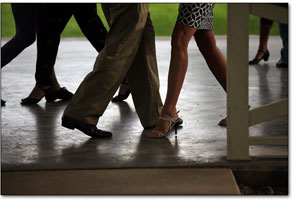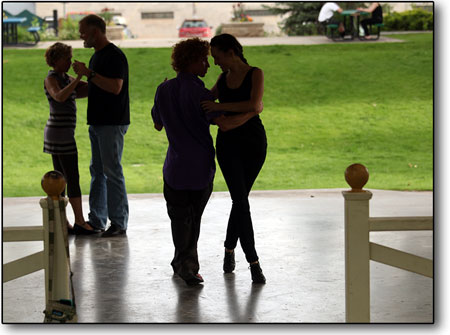|
|
Doing the Durango tango
Local scene heats up the dance floor
by Stew Mosberg
Durango is a long way from the barrios of Buenos Aires, cellars of Paris or 20th century supper clubs of New York. But, they all have one thing in common: tango, a cross-cultural dance form that crosses international borders with its mystique and music.
For many, once tango is experienced, it becomes an obsession. Like many complex activities, the fundamentals might be learned reasonably fast, but mastery is a life-long pursuit. As for the origin of the word itself, Buenos Aires experienced a huge influx of European immigrants around the turn of the 20th century, many from Naples, Italy. In Buenos Aires, the word for Italian is “tano” – a shortened form of Neapoli-tano or Neapolitan – and these émigrés brought with them their lyrical music and precise dance steps that popularized the music around the world.
After falling from popularity during the latter part of the century for political and social reasons, the tango began to re-emerge in the 1980s and has grown in popularity ever since.
Durango dance aficionados have tapped into this obsession with fervor. According to Ljuba Lemke, one of the community’s most ardent fans, it was in early 2012 that local dancers Harold Welty, Keneen McNiven and Perri Iezzoni started Durango Tango. To do so, they gathered email addresses from people who were interested, set up a web site and Facebook page, organized a space and invited a tango instructor to teach a few classes. “We got together every Sunday, sometimes having a workshop, other times just practicing,” recalled Lemke. Iezzoni, one of the founders, wrote a short book, Fear of Intimacy and the Tango Cure, which candidly shares his perspective of the dance and its ability to transform people; namely himself.
Lemke, a dentist, has been in Durango since 2008 and started tangoing in early 2012. She was hooked from the first step and took workshops elsewhere and attended tango festivals – one of the world’s largest is held in Albuquerque in October.
“Wherever I travel,” Lemke says, “I normally find tango, including Canada, Mexico and Germany.”
Acknowledging that tango can be overwhelming for most beginners, the native German candidly admits, “I realize that I was blue-eyed enough to not understand that tango indeed is daunting; lucky me because that helped me learn it faster.”
One reason it might be intimidating is because it has an inherent quality of intimacy, “Which,” Lemke says, “might make us more self-conscious, more vulnerable. In other dances we talk about the dance hold (but) in tango it is called the embrace. Tango is a conversation between two people using body language. There is a certain vocabulary but no set patterns and much room for improvisation.”
Discussing the nuances of the tango, Welty willingly shares his knowledge and expertise with enthusiastic attendees at the local events. Dancing tango 4 for the past eight years, he said he became serious about five years ago. It was around then that he helped start Durango Tango with people he met at the Wild Horse Saloon. The group now numbers more than 150 on its email list.
“Argentine tango is about connection, not about steps; it is about following the music,” Welty said of the subtleties one might encounter on the dance floor.
Welty believes new “tangueros” are challenged because tango has none of the structure found in most other dances. “It takes a while to feel the freedom; to be improvisational,” he adds. “Tango is very Zen.”
 “If you can walk, you can learn to dance,” claims local tango instructor Leslie Carlson, adding that the basic process of tango is walking./ Photo by Steve Eginoire |
Dancers can choose between two holds or, as Lemke explains, embraces. “Milanguero” is a tight, close embrace with the leader’s arm around the lower back of the follower, whereas “Salon” is the more open embrace, allowing for more space between the dancers. In tango the woman always follows, the man leads. It’s not sexist, Welty says, because one partner cannot exist without the other. The role of each dancer is quite clear and extremely important. “Following the follower is a big part of being a leader,” he says. “The lead is only an invitation, not an order.”
The follower gets to perform most of the embellishments, the foot and leg movements that make the dance so sensual. In reality, when the woman wears a high-slit skirt, it is more functional than prurient. Although tango is often considered provocative, the unspoken rules, or “codigos,” are relatively conservative and avoid overt sexuality. Rather, civility, respectfulness and consideration are all hallmarks of the serious dancers.
To add even more confusion, the word “milonga” – from which milangeuro is derived – has several meanings; it can be a place where dancers gather or it can also refer to the music itself.
One of the few tango instructors in Durango is Leslie Carlson, of GrooveU dance studio. Monday nights at her studio are devoted to group tango lessons and newcomers are welcomed along with the “regulars.” Carlson has been dancing professionally for more than 25 years and received her training with Arthur Murray International in the New Orleans region.
Carlson focuses on Argentine Tango as opposed to American or other variations, and is encouraging when she says, “The learning curve depends heavily on the individual student; some seem to be naturals and others may feel more challenged. But, it really is true that if you can walk you can learn to dance. And the basic movement in tango is walking, which simplifies the process a bit.”
According to Carlson, her students and the tango community in Durango are from varied walks of life, “The Durango tango community is a model of diversity: teachers, doctors, students, service industry, construction dudes and even a field hand or two make up the group,” she says. But, whether learning a simple box step, or practicing aguias, barridas, ganchos and zapatazos, the social aspect of being with like-minded people of all ages and levels of proficiency makes the pursuit worthwhile.
Excavating contractor Jason Chapman, for example, decided to give tango a try last February because several people he knew told him how much they enjoyed it. “The (tango) is appealing to me because it is so sultry, graceful and elegant,” he says.
For more information, go to www.TangoDurango.com. While there is no charge to “join” donations are gratefully accepted to help offset the cost of a sound system, guest instructors, bands and demonstrations. Leslie Carlson of Groove U can be reached at:(970)799-8832. The studio is located at 26369 Hwy 160, Durango (Dietz Market). Milongas are also held at Four Leaves Winery, 528 Main Ave., one Tuesday a month.

